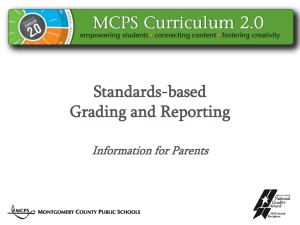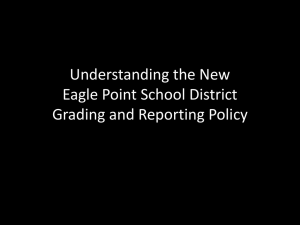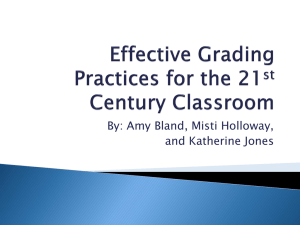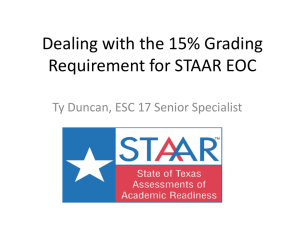PPT
advertisement
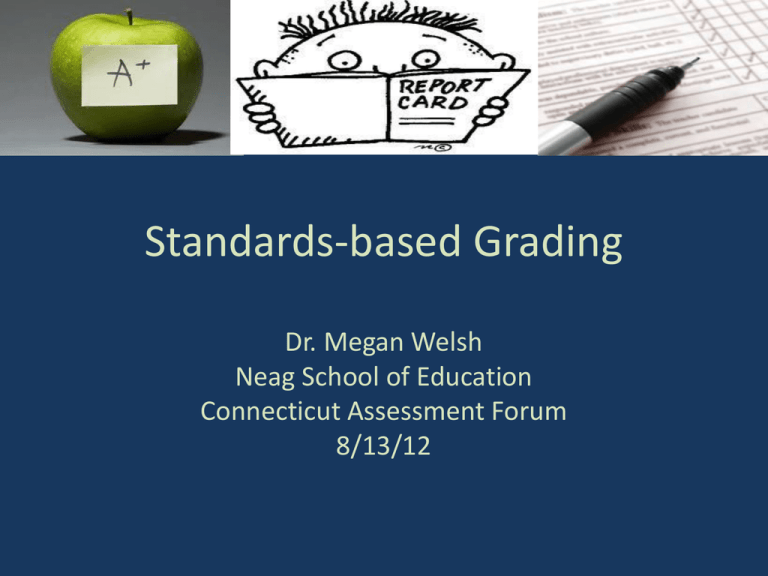
Standards-based Grading Dr. Megan Welsh Neag School of Education Connecticut Assessment Forum 8/13/12 The study • Data from one suburban school district located in the Southwest (13 elementary schools) • Focused on third and fifth grade (~4000 students over two years) • Data collected included standards-based grades and state test scores, in two years, and interviews of approximately 40 teachers. Interviews focused largely on mathematics instruction and grading Goals Today Discuss the promise and potential pitfalls of standards-based grading, drawing context from a study conducted in one district. Why grade? 1. To communicate with parents about student Giving feedback: achievement 1. Ask clarifying questions Therefore, grading is all about values 2. State what you value 2. To provide information to students about Feedback performance 3. their Discuss how the performance/ behavior at hand is consistent or inconsistent with your values 3. To track student progress over time What are your values? Do you believe…. Grades should reflect achievement of intended learning outcomes—whether the school is using a conventional, subject-based report card or a report card that represents these intended learning outcomes as standards. What are your values? Do you believe…. The primary audiences for the message conveyed in grades are students and their parents; grading policies should aim to give them useful, timely, actionable information. Teachers, administrators, and other educators are secondary audiences. What are your values? Do you believe…. Grades should reflect a particular student’s individual achievement. Group and cooperative skills are important, but they should be reflected elsewhere, not in an individual’s academic grade. What are your values? Do you believe…. Grading policies should be set up to support student motivation to learn. A student should never reach a place where there is no point doing any more work because failure is inevitable. The promise…. Standards-based grading is intended to support these values, while also… 1. Improving alignment of curriculum and standards 2. Improving communication with parents 3. Generating scores that can be directly compared with state tests What is standards-based grading? Report cards that… • Grade students according to performance level descriptors, usually in line with the state test (Advanced, Goal, Proficient, etc.) • Grade according to specific strands or objectives found in state standards documents (or the Common Core State Standards) Tend to be more widespread at the elementary level due to the specificity of objectives Standards-based report cards, some examples Some considerations in adopting a standards-based report card 1. How to get buy in from teachers, principals and parents? 2. What professional development is needed? 3. How to monitor implementation of the new approach? Some considerations in developing a standards-based report card 1. What grading scale to use? 2. Whether to grade on objectives, strands, or content areas? 3. Which objectives/strands/content areas to select? 4. Whether (and how) to adapt forms or grading policies for English language learners and students with disabilities? What grading scale to use? If you want to be able to compare report card grades to state test scores, then you should use the state test performance levels. This is easier said than done…. Each teacher is likely to interpret the performance levels differently. Year 1 No guidance on how to operationalize each performance level. Year 2 90 and above=“Exceeds,” “80 and above=“Meets,” etc. Performance Level Geometry and Measurement Descriptors (Grade 3) But what does it really mean Below Basic Limited ability to… to “Meet” thetimestandard? 1. Solve problems involving You can 2.Estimate lengths and areas 3. Measure lengths and identify appropriate measurement units a given situation getforguidance from the state…. 4.Identify, classify and draw 2-dimensional shapes Basic 1. Adequately solve problems involving time 2. Marginally estimate lengths and areas http://www.csde.state.ct.us/public/cedar/assessment/ 3. Marginally measure lengths and identify appropriate cmt/cmt_gen4_resources.htm measurement units for a given situation 4. Competently identify, classify and draw 2-dimensional shapes Proficient 1. Competently solve problems involving time 2. Marginally estimate lengths and areas 3. Marginally measure lengths and identify appropriate measurement units for a given situation 4. Competently identify, classify and draw 2-dimensional shapes Whether to grade on objectives, strands, or content areas? Who is the primary audience? Teachers if grading on specific objectives, they must teach and assess those objectives Parents how much information can they reasonably digest? Which objectives/strands/content areas to select? What is MOST important? 1. Endurance: Skills that will stay with students for a long time 2. Leverage: Skills that are applicable to many academic disciplines (e.g., nonfiction writing, reading tables and charts) 3. Readiness for the next level of instruction: Skills that students must have for success in the next grade/course Adaptations for English language learners and students with disabilities? 1. Ask whether the standard is an appropriate expectation without adaptations. 2. If the standard is not appropriate, determine what type of adaptation the standard needs. 3. If the standard needs modification, determine the appropriate standard. 4. Base grades on the modified standard, not the grade-level standard. 5. Communicate the meaning of the grade. Some considerations in generating a standards-based grade Organizing for grading…. 1. Grade book: specify the skills associated with each score 2. What kinds of scores to record in the grade book and how will they be converted to performance levels? 3. Assessments: can focus on one skill at a time, or encompass multiple skills. If multiple skills are assessed, teachers must generate skill-specific scores Some considerations in generating a standards-based grade Decide what kinds of achievement grades reflect Product: what students know and are able to do at a particular point in time Process: students' behaviors in reaching their current level of achievement and proficiency Progress: how much students improve or gain from their learning experiences Product Grades reflect student achievement at one point in time. Some decisions: - Should grades reflect performance in relation to end of year expectations, or in relation to expectations at the time the grade is recorded? - When a unit is completed and skill assessed in September, should the end-of-year grade be based on September performance or be reassessed? Process Grades reflect student work habits. Some decisions: - How to incorporate incomplete work in grades? - How to incorporate homework in grades? - What to do if a student works very diligently, but does not perform well. Progress Grades reflect amount of improvement made over the school year. Student 9/1 9/8 9/15 9/22 9/29 10/6 10/13 Wayne, Bruce 70 73 75 78 85 90 90 95 82 Prince, Diana 81 81 83 81 83 83 82 82 82 Kyle, Selina 95 90 90 85 78 75 73 70 82 10/20 Mean From design considerations…. To evaluation of one approach The study Gathered data in one district, which experienced a headline similar to the one shown previously. The study: 1. Evaluated the degree of consistency between grades and test scores 2. Identified grading practices that yielded greater consistency 3. Determined how much of the difference between grades and test scores could be attributed to subject, teacher, and year 4. Asked teachers about their experiences with the method District grading policy In its 3rd year of standards-based grading during interviews Year 1 Reported by strand or objective, depending on grade level Years 2/3 Reported by strand and content area, with strands graded on a -. √, + basis Asked teachers to take students’ Asked teachers to grade based on “pattern of progress” into consideration achievement level at the end of the in generating grades marking period Required teachers to decide for themselves how to operationalize each performance level Extensive professional development on grading, including the importance of grading effort separately Required teachers to convert percent correct to performance levels (>89%=A) Limited professional development, some to address changes to reporting system. Many teachers seemed unaware of changes in policy. The Study 1. Evaluated the degree of consistency between grades and test scores State test Three ways toFalls think about consistency: Far Below Approaches Meets Falls Far Below Johnny Sally Bruce Craig James Kate Janice Jessica Darren Exceeds 1. Do grades and test scores match exactly. Approaches Grades Kevin 2. Is the list of students rank-ordered Mia by grade Meets Glen Huihui Tess Becky similar to the list rank-ordered by Hunter test score? Will Holly Dan Phoebe Ruth Wayne Lesley Victoria 3. How large is the difference between grades and test scores? Exceeds The Study 1. Evaluated the degree of consistency between grades and test scores Writing Mathematics Reading The Study 2. Identified grading practices that predict consistency Grading practice The extent to which the teacher…. Performance-focused Graded on attainment of standards instead of effort Overall achievement Focused on overall achievement rather than student progress Frequently assessed Regularly collected assessment data for grading purposes Multiple approaches Used assessments that encompass different aspects of a skill Linked assessments to objectives Identified the performance objectives addressed on assessments and maintained objective-based records Clear grading method Could explain a method of converting assessment scores to grades Created assessments Created their own assessments linked to the academic standards. Assessed most objectives Made an effort to assess most objectives in the state standards Standards-focused Focused on assessing standards more than curriculum attainment The Study 2. Identified grading practices that predict consistency We found no relationship between grading - -Teachers who adopted standards-based gradingpractices practices andto consistency rank-order tended assign theof exact same performance level as the state test We found no relationship between grading - -Teachers who adopted standards-based gradingpractices practices andto grading reading tended grade rigor lowerinthan the test in mathematics and higher than the test in writing However, these relationships are weak to moderate The Study 3. Sources of variation in convergence rates Test –Exact Rank-order gradematch difference The Study 4. Teacher experiences with standards-based grades Many teachers faithfully implemented standards-based grading and were supportive However, a few concerns arose…… Concern #1 Lack of alignment between the curriculum and the standards - All 3rd grade teachers reported that the mathematics text was not aligned with state standards - The district put considerable pressure on teachers to follow the text without supplementing it Standardsbased grading District-adopted curriculum Concern #2 Interpretability WA districts address common concern with standards-based grading Teachers and parents initially found the system confusing. This made the newspapers. Concern #3 Solve word problems Feasibility 9/1 Quiz 9/1 Quiz Organizing for grading was tough. Sally 8/10 GM1. length/area 9/10 GM2. time Joe 9/10 GM1. length/area 8/10 GM2. time Stacy 10/10 GM1. length/area 10/10 GM2. time Jim 7/10 GM1. length/area 7/10 GM2. time OR 9/1 Quiz 7/10 8/10 9/10 9/10 GM3. measuring GM3. measuring GM3. measuring GM3. measuring Write numbers as words 9/1 Quiz GM1 9/1 Quiz GM2 9/1 Quiz GM3 Sally 8/10 9/10 7/10 Joe 9/10 8/10 8/10 Stacy 10/10 10/10 9/10 Jim 7/10 7/10 9/10 Concern #4 Changing messages/expectations as the report card format changed Recommendations 1. Design a grading system consistent with your district’s values… -What skills to include? -What grading scale to use? -Usefulness as a communication tool with whom? -Whether to grade on process, progress, or product? -How to communicate about student behaviors? -How to grade students with special needs? Recommendations 2. Communicate about those values -With district employees -With the community -With parents 3. Use those values as context for why you are adopting standards-based grades Recommendations 4. Develop a report card form and a grading policy, with input from teachers, administrators, parents, and community members 5. Pilot the report card in a small number of schools and gather feedback from teachers, parents and students about it 6. List to the feedback. Use it to revise the grading policies/report card format Recommendations 7. Market the final version of the report card to parents, community members, and district employees. Communicate the reason for adopting the new grading system, again couched in district values 8. Train educators how to use the report card: • • • • organizing for grading grading method (process, product, progress) operationalizing the report card scale (e.g., What does “Goal” look like)? grading students with special needs Recommendations 9. Train them again…. Train them every year…… 10. Evaluate the grading system. Share results with teachers, parents, community members and administrators. 11. Explain how you (and they) should use the results to make changes Thank you! Do you have any questions or comments? Dr. Megan Welsh Neag School of Education Department of Educational Psychology 249 Glenbrook Rd. Unit 2064 Storrs, CT 06269 (860) 486-6125 megan.welsh@uconn.edu Some good references



